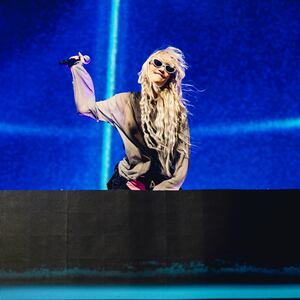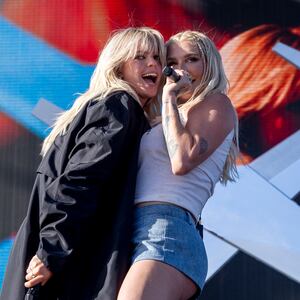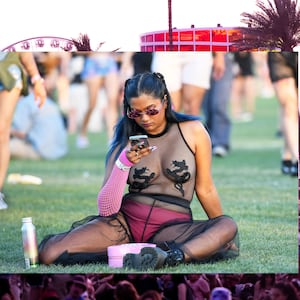“Bro, I already saw Tyler at Flog Gnaw,” said a guy dressed in a flowery button-down to his friend, also in a flowery button-down. Tyler, the Creator, who put on his own festival at Dodger Stadium last fall, burst through a wall, kicking off his Coachella headlining set with the buzzing bass of “IGOR’S THEME.” But by the time I met up with my friend in the crowd, the pair had already left to see Dom Dolla, the DJ playing at the Sahara stage.
In a way, my friends-in-floral summarized what many, including myself, hypothesized during the lead up to this year’s fest. My doubts were never about whether Coachella would provide festival goers with exceptional music or a weekend of sweaty, sunny, sand-filled fun. My concerns were about whether this festival would matter as much as it had before.
Even with a lineup of EDM rarities, ’90s nostalgia reunions, rising pop stars, and artists from around the globe, Coachella lost a little luster without a shocking, triumphant headliner. Rumors of low ticket sales called the festival’s status into question. Headliners don’t shape the attendees’ day-to-day experience, but they do give Coachella its ubiquity and induce FOMO outside the desert. On a personal level, I, like the majority of the attendees, had a blast (Favorite sets: Militarie Gun, Chappell Roan, Tyler, the Creator, and Justice). But at the same time, it was the end of Coachella’s influence in the larger music culture.
ADVERTISEMENT
Despite the year’s grumbly start, festival goers, A-listers, and an enormous sculpture of a horse named Mustang descended upon the Empire Polo Club in Indio, California, for Coachella 2024. Logistically, Coachella went about its business smoothly. The headliners showed up on time. There were surprise additions to the lineup, special guests, and plenty of great music. It was not the sparsely attended disaster that naysayers predicted. It continued to be the dominant music festival in the US. But it also wasn’t the full-blown spectacle that it had been for the last few years. This year, Goldenvoice, the promotion company behind the festival, chose reliability over uniqueness. For all the hand-wringing, this was pretty much just a “normal” Coachella. And for better or for worse, there hasn’t been a “normal” Coachella in nearly a decade.

Kid Cudi performs at the Sahara Tent during the 2024 Coachella music festival.
Theo Wargo/Theo Wargo/Getty Images for CoachellaThere were a few hiccups. Art-pop diva Grimes bombed her Weekend One set. It was an obvious disaster, plagued by technical difficulties, lack of rehearsal, and her own frustrated screams. Blur’s Damon Albarn complained about the crowd’s lack of enthusiasm for their 1994 hit “Girls and Boys.” In Weekend Two, surprise lineup addition Kid Cudi broke his leg jumping off the stage. The much-anticipated hologram act Hatsune Miku disappointed fans when the hologram didn’t show up.
But there were no issues with this year’s headliners: Lana Del Rey, Tyler, the Creator, and Doja Cat. While Goldenvoice was likely relieved that it didn’t have to manage another last-minute headliner crisis, they also lost the prestige of booking a unique draw. Although the recent headliner swaps, cancelations, and rebookings often left fans disappointed and frustrated, they also ensured Coachella’s status as America’s signature festival. Goldenvoice could replace premier A-listers with other premier A-listers. They aimed for the most exclusive artists possible.
This year, the headliners kept things by the book. All three have performed across America in the last two years, and their sets were similar to the tried-and-true shows they’ve taken on tour. There were a few variations: Doja Cat debuted material from the deluxe version of her 2023 album Scarlet, and Tyler, the Creator added a few more fan favorites to his usual repertoire. Del Rey rode into the stage on a motorcycle. All three headliners brought out special guests. However, no one had the Imperial Era fanfare of Bad Bunny, the crowd’s electric excitement for Harry Styles, or the one-of-a-kind booking that paired Dr. Dre and Snoop Dogg. While all three artists were worthy of headlining, they weren’t the festival exclusives that Coachella usually enjoys.

Tyler, the Creator headlines on the second night of the Coachella.
Dania Maxwell/Los Angeles Times via Getty ImagesFor the most part, that was good enough. Tyler’s raucous charm and Doja’s razor-sharp choreography fired up the Main Stage. Del Rey’s set was shakier. Her melancholy pop was at home in the California desert, and her duets with Billie Eilish in Weekend One felt like a love letter to all the artists she’s inspired (Eilish: “[Lana is] the reason for half of you bitches existence, including mine”). But that goodwill didn’t extend to Weekend Two, when Del Rey brought out Camilla Cabello. Cabello performed her latest single “I Luv It” while Lana smiled along. It was an odd, unrelated interruption, and it read more like a label-sponsored ad than a Coachella-exclusive moment.
The real draw of the fest remains its rich undercard, which features unmatched diversity and depth. K-Pop’s presence continues to grow with sets from Le Sserafim, ATEEZ, and The Rose. Latin music—from the sub-headliners J Balvin and Peso Pluma to beat-maker Bizarrap to the Sonora-packing LATIN MAFIA—drew huge crowds. Coachella and Goldenvoice provide one-of-a-kind experiences not just on the Main Stage, but from the Sonora to the Sahara.
Electronic music has always been central to Coachella. But this year, EDM dominated more than ever. A new stage—called the Quasar—featured hours-long, back-to-back sets from DJs including Diplo, Eric Prydz, Anyma, Jamie xx, and Rüfüs Du Sol. The Sahara stage, which also often houses EDM, was positioned near Quasar, far from the rest of the fest. With the EDM-focused stages like Quasar, Sahara, Yuma and the Do LaB all on one side, it felt like two concurrent festivals, electronic music separated from everything else.
Plus, many of the most unexpected artists of the year were EDM. Acts like Justice, Gesaffelstein, and Anti Up provided some of the exclusivity that Coachella was missing in other genres. DJs John Summit and Dom Dolla were on double duty, both booked under their own name and playing under their duo alias, Everything Always. Rarities like Justice and Gesaffelstein didn’t disappoint, but the festival lost its balance. Goldenvoice relegated much of the contemporary rock that would feel at home in Indio to their other festivals Just Like Heaven, Cruel World, and No Values. Rap was also noticeably absent besides three big names—Doja Cat, Tyler, the Creator, and Lil Uzi Vert. Coachella can’t appeal to everyone, but this year’s emphasis on electronic was a clear sign as to whom they prioritize.

Gwen Stefani of No Doubt performs during the 2024 Coachella Valley Music and Arts Festival.
Timothy Norris/Getty Images for CoachellaAs expected, there was a laundry list of only-at-Coachella moments: No Doubt’s reunion and surprise guest Olivia Rodrigo was a complete triumph, Billie Eilish debuted material from her upcoming album when she took over the Do LaB, Chappell Roan made the Gobi feel like the Main Stage with a set that poured gasoline on the flames of her pop ascent, Blur had their supposedly final ever performance. There was an endless list of special guests: J Balvin brought out Will Smith, Kevin Abstract featured Sky Ferreira and Lil Nas X, Shakira at Bizarrap, Lauryn Hill at YG Marley, Kesha at Reneé Rapp.

Blur performs during Coachella on Saturday, April 13, 2024 in Indio, CA.
Dania Maxwell/Los Angeles Times via Getty ImagesBut outside the desert, Coachella was overshadowed. A colossal truck promoting Beyoncé’s Cowboy Carter parked directly outside the festival entrance, and Cowboy Carter banners flew in the sky, reminders that the festival will never capture the same global audience as Beyoncé’s Homecoming. With the focus away from headliners, Coachella didn’t have the same christening of superstars of years past. Taylor Swift released an album, which flooded away any fleeting attention paid to the exciting guests and moments from Weekend Two.
The criticisms Coachella faced prior to the festival are still valid. For many, a festival that costs $600 (excluding transportation, lodging, food) without the one-of-a-kind booking like Frank Ocean is exorbitant. And the festival’s lower ticket sales prove that an eclectic lineup of rising stars and top-line rarities still isn’t enough to sell it out.
But for those of us at the festival, the big news of this year’s Coachella was its great live acts—No Doubt, Justice, Deftones, Charlotte De Witte, Tyler, the Creator—continued to be great live acts. Business as usual. The festival transitioned away from its spectacle, for better and worse, to a more functional lineup. The daily experience was a bit more relaxed. There were fewer sets to cram into each day, lighter crowds, and more festival goers who weren’t camping out for one artist. Coachella didn’t have its Beyoncé or Bad Bunny-type sets, but that left more space for the smaller, more intimate, and unique acts that give Coachella its true charm.
I imagine attendees are split on whether or not Coachella needs to be important going forward. But it is one of the few places in mainstream music culture that offers something we’re in desperate need of: unpredictability. Annual music events like the Grammys and the Super Bowl Halftime are tampered down to appeal to the greatest common denominator.
But at Coachella, artists bring their unfiltered selves to the stage. They react to the crowds, surprise the audience, and go viral for yelling “Fuck P Diddy.” Unlike the polish of an arena tour or the commercialism of awards shows, Coachella puts a little sand and dust into the performances of our faves: mics don’t work, established artists can have trainwreck sets, and rising artists prove themselves on its stages.
Coachella has had a tumultuous decade—they collected their flowers for their big, Beychella-grade wins and lost those flowers when Frank Ocean did… whatever that was. But “normal” Coachellas might mean we lose one of the last remaining platforms for Earth-shaking performances. Or maybe, it’ll make the desert more spacious for those of us who keep coming back.









